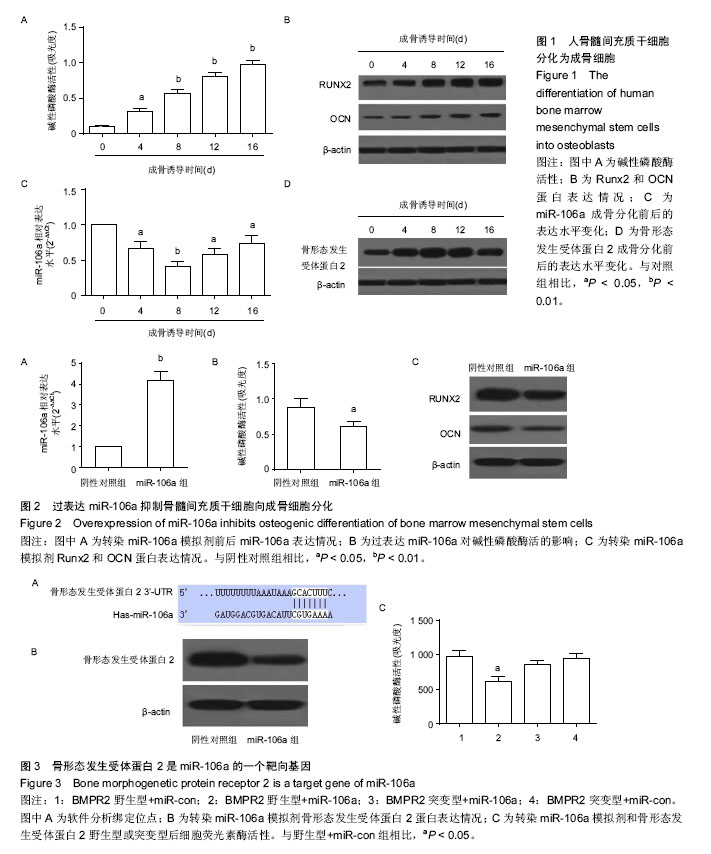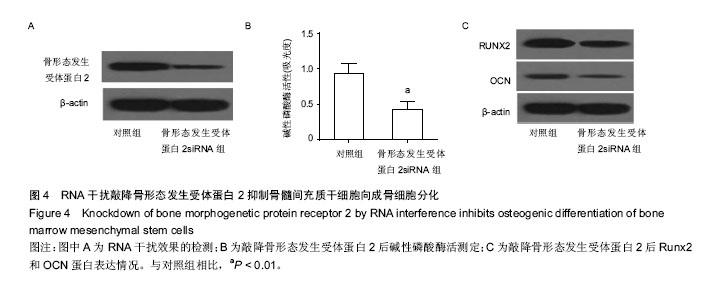| [1] Katagiri T, Takahashi N. Regulatory mechanisms of osteoblast and osteoclast differentiation. Oral Dis. 2002;8(3):147-159.
[2] Nakashima K, de Crombrugghe B. Transcriptional mechanisms in osteoblast differentiation and bone formation. Trends Genet. 2003;19(8):458-466.
[3] Vimalraj S, Selvamurugan N. MicroRNAs: Synthesis, Gene Regulation and Osteoblast Differentiation. Curr Issues Mol Biol. 2013;15:7-18.
[4] Sacchetti B, Funari A, Michienzi S, et al. Self-renewing osteoprogenitors in bone marrow sinusoids can organize a hematopoietic microenvironment. Cell. 2007;131(2):324-336.
[5] Vimalraj S, Selvamurugan N. MicroRNAs expression and their regulatory networks during mesenchymal stem cells differentiation toward osteoblasts. Int J Biol Macromol. 2014;66:194-202.
[6] Wei J, Li H, Wang S, et al. let-7 enhances osteogenesis and bone formation while repressing adipogenesis of human stromal/mesenchymal stem cells by regulating HMGA2. Stem Cells Dev. 2014; 23(13):1452-1463.
[7] Lian JB, Stein GS, van Wijnen AJ, et al. MicroRNA control of bone formation and homeostasis. Nat Rev Endocrinol. 2012;8(4):212-227.
[8] Taipaleenmäki H, Bjerre Hokland L, Chen L, et al. Mechanisms in endocrinology: micro-RNAs: targets for enhancing osteoblast differentiation and bone formation. Eur J Endocrinol. 2012;166(3):359-371.
[9] Thomas M, Lieberman J, Lal A. Desperately seeking microRNA targets. Nat Struct Mol Biol. 2010;17(10): 1169-1174.
[10] Esteller M. Non-coding RNAs in human disease. Nat Rev Genet. 2011;12(12):861-874.
[11] Bushati N, Cohen SM. microRNA functions. Annu Rev Cell Dev Biol. 2007;23:175-205.
[12] Schoolmeesters A, Eklund T, Leake D, et al. Functional profiling reveals critical role for miRNA in differentiation of human mesenchymal stem cells. PLoS One. 2009; 4(5):e5605.
[13] Baglìo SR, Devescovi V, Granchi D, et al. MicroRNA expression profiling of human bone marrow mesenchymal stem cells during osteogenic differentiation reveals Osterix regulation by miR-31. Gene. 2013;527(1):321-331.
[14] Hu R, Li H, Liu W, et al. Targeting miRNAs in osteoblast differentiation and bone formation. Expert Opin Ther Targets. 2010;14(10):1109-1120.
[15] Luzi E, Marini F, Sala SC, et al. Osteogenic differentiation of human adipose tissue-derived stem cells is modulated by the miR-26a targeting of the SMAD1 transcription factor. J Bone Miner Res. 2008; 23(2):287-295.
[16] Kim YJ, Bae SW, Yu SS, et al. miR-196a regulates proliferation and osteogenic differentiation in mesenchymal stem cells derived from human adipose tissue. J Bone Miner Res. 2009;24(5):816-825.
[17] Huang S, Wang S, Bian C, et al. Upregulation of miR-22 promotes osteogenic differentiation and inhibits adipogenic differentiation of human adipose tissue-derived mesenchymal stem cells by repressing HDAC6 protein expression. Stem Cells Dev. 2012; 21(13): 2531-2540.
[18] Zhu M, Zhang N, He S, et al. MicroRNA-106a targets TIMP2 to regulate invasion and metastasis of gastric cancer. FEBS Lett. 2014;588(4):600-607.
[19] Yuan R, Zhi Q, Zhao H, et al. Upregulated expression of miR-106a by DNA hypomethylation plays an oncogenic role in hepatocellular carcinoma. Tumour Biol. 2015;36(4):3093-3100.
[20] Xie X, Liu HT, Mei J, et al. miR-106a promotes growth and metastasis of non-small cell lung cancer by targeting PTEN. Int J Clin Exp Pathol. 2015;8(4): 3827-3834.
[21] Li P, Xu Q, Zhang D, et al. Upregulated miR-106a plays an oncogenic role in pancreatic cancer. FEBS Lett. 2014;588(5):705-712.
[22] Wang Z, Liu M, Zhu H, et al. miR-106a is frequently upregulated in gastric cancer and inhibits the extrinsic apoptotic pathway by targeting FAS. Mol Carcinog. 2013;52(8):634-646.
[23] Wang W, Corrigan-Cummins M, Hudson J, et al. MicroRNA profiling of follicular lymphoma identifies microRNAs related to cell proliferation and tumor response. Haematologica. 2012;97(4):586-594.
[24] Zhi F, Zhou G, Shao N, et al. miR-106a-5p inhibits the proliferation and migration of astrocytoma cells and promotes apoptosis by targeting FASTK. PLoS One. 2013;8(8):e72390.
[25] Gao J, Yang T, Han J, et al. MicroRNA expression during osteogenic differentiation of human multipotent mesenchymal stromal cells from bone marrow. J Cell Biochem. 2011;112(7):1844-1856.
[26] 张贤,蔡建平,张艳红,等.杜仲诱导大鼠间充质干细胞成骨分化中成骨与成脂相关转录因子的表达[J].中国组织工程研究,2010,14(19):3523-3526.
[27] Sun H, Ye F, Wang J, et al. The upregulation of osteoblast marker genes in mesenchymal stem cells prove the osteoinductivity of hydroxyapatite/tricalcium phosphate biomaterial. Transplant Proc. 2008;40(8): 2645-2648.
[28] Nukavarapu SP, Dorcemus DL. Osteochondral tissue engineering: current strategies and challenges. Biotechnol Adv. 2013;31(5):706-721.
[29] Mendell JT. miRiad roles for the miR-17-92 cluster in development and disease. Cell. 2008;133(2):217-222.
[30] Wang Z, Wang B, Shi Y, et al. Oncogenic miR-20a and miR-106a enhance the invasiveness of human glioma stem cells by directly targeting TIMP-2. Oncogene. 2015;34(11):1407-1419.
[31] Larabee SM, Coia H, Jones S, et al. miRNA-17 members that target Bmpr2 influence signaling mechanisms important for embryonic stem cell differentiation in vitro and gastrulation in embryos. Stem Cells Dev. 2015;24(3):354-371.
[32] Selbach M, Schwanhäusser B, Thierfelder N, et al. Widespread changes in protein synthesis induced by microRNAs. Nature. 2008;455(7209):58-63.
[33] 罗渊,田亚平.microRNA 的调控和被调控[J].中国生物化学与分子生物学报,2014,30(12):1176-1181.
[34] Wei Y, Nazari-Jahantigh M, Chan L, et al. The microRNA-342-5p fosters inflammatory macrophage activation through an Akt1- and microRNA-155- dependent pathway during atherosclerosis. Circulation. 2013;127(15):1609-1619.
[35] Zeng Y, Qu X, Li H, et al. MicroRNA-100 regulates osteogenic differentiation of human adipose-derived mesenchymal stem cells by targeting BMPR2. FEBS Lett. 2012;586(16):2375-2381.
[36] Yang Z, Hao J, Hu ZM. MicroRNA expression profiles in human adipose-derived stem cells during chondrogenic differentiation. Int J Mol Med. 2015; 35(3):579-586.
[37] Yuan B, Sun GJ, Zhang GL, et al. Identification of target genes for adenohypophysis-prefer miR-7 and miR-375 in cattle. Genet Mol Res. 2015;14(3):9753- 9763.
[38] Brock M, Trenkmann M, Gay RE, et al. Interleukin-6 modulates the expression of the bone morphogenic protein receptor type II through a novel STAT3- microRNA cluster 17/92 pathway. Circ Res. 2009;104 (10):1184-1191.
[39] Chen F, Lin X, Xu P, et al. Nuclear Export of Smads by RanBP3L Regulates Bone Morphogenetic Protein Signaling and Mesenchymal Stem Cell Differentiation. Mol Cell Biol. 2015;35(10):1700-1711.
[40] Li B, Tian XB, Hu RY, et al. Mechanism of BMP and TG2 in mesenchymal stem cell osteogenesis. Eur Rev Med Pharmacol Sci. 2015;19(22):4214-4219.
[41] Wang A, Ding X, Sheng S, et al. Bone morphogenetic protein receptor in the osteogenic differentiation of rat bone marrow stromal cells. Yonsei Med J. 2010;51(5): 740-745.
[42] 王茸影,易静.骨形成蛋白调控成骨分化的信号机制[J].生命科学,2005,17(1):34-39. |
.jpg) 文题释义:
成骨细胞:是骨形成的主要功能细胞,负责骨基质的合成、分泌和矿化。骨不断地进行着重建,骨重建过程包括破骨细胞贴附在旧骨区域,分泌酸性物质溶解矿物质,分泌蛋白酶消化骨基质,形成骨吸收陷窝;其后,成骨细胞移行至被吸收部位,分泌骨基质,骨基质矿化而形成新骨。
人骨髓间充质干细胞:是一种成体干细胞,不但能向中胚层的各种细胞如骨、软骨等分化,还能向外胚层的神经细胞、内胚层的消化和内分泌细胞如肝细胞和胰岛样细胞分化。1999年,Pittenger等首先用单细胞培养的方法获取了人骨髓基质细胞集落,进一步将此来自一个克隆的细胞分化为成骨细胞、软骨细胞和脂肪细胞。
文题释义:
成骨细胞:是骨形成的主要功能细胞,负责骨基质的合成、分泌和矿化。骨不断地进行着重建,骨重建过程包括破骨细胞贴附在旧骨区域,分泌酸性物质溶解矿物质,分泌蛋白酶消化骨基质,形成骨吸收陷窝;其后,成骨细胞移行至被吸收部位,分泌骨基质,骨基质矿化而形成新骨。
人骨髓间充质干细胞:是一种成体干细胞,不但能向中胚层的各种细胞如骨、软骨等分化,还能向外胚层的神经细胞、内胚层的消化和内分泌细胞如肝细胞和胰岛样细胞分化。1999年,Pittenger等首先用单细胞培养的方法获取了人骨髓基质细胞集落,进一步将此来自一个克隆的细胞分化为成骨细胞、软骨细胞和脂肪细胞。

.jpg)
.jpg) 文题释义:
成骨细胞:是骨形成的主要功能细胞,负责骨基质的合成、分泌和矿化。骨不断地进行着重建,骨重建过程包括破骨细胞贴附在旧骨区域,分泌酸性物质溶解矿物质,分泌蛋白酶消化骨基质,形成骨吸收陷窝;其后,成骨细胞移行至被吸收部位,分泌骨基质,骨基质矿化而形成新骨。
人骨髓间充质干细胞:是一种成体干细胞,不但能向中胚层的各种细胞如骨、软骨等分化,还能向外胚层的神经细胞、内胚层的消化和内分泌细胞如肝细胞和胰岛样细胞分化。1999年,Pittenger等首先用单细胞培养的方法获取了人骨髓基质细胞集落,进一步将此来自一个克隆的细胞分化为成骨细胞、软骨细胞和脂肪细胞。
文题释义:
成骨细胞:是骨形成的主要功能细胞,负责骨基质的合成、分泌和矿化。骨不断地进行着重建,骨重建过程包括破骨细胞贴附在旧骨区域,分泌酸性物质溶解矿物质,分泌蛋白酶消化骨基质,形成骨吸收陷窝;其后,成骨细胞移行至被吸收部位,分泌骨基质,骨基质矿化而形成新骨。
人骨髓间充质干细胞:是一种成体干细胞,不但能向中胚层的各种细胞如骨、软骨等分化,还能向外胚层的神经细胞、内胚层的消化和内分泌细胞如肝细胞和胰岛样细胞分化。1999年,Pittenger等首先用单细胞培养的方法获取了人骨髓基质细胞集落,进一步将此来自一个克隆的细胞分化为成骨细胞、软骨细胞和脂肪细胞。